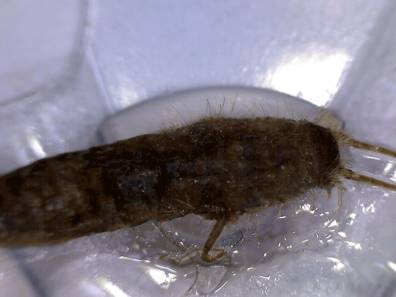Long-tailed silverfish - paper eaters will cause delicate damage
A new threat involved in pest infestation (IPM - Integrated Pest Management)
Until now, the infiltration of long-tailed silverfish or gray silverfish (Ctenolepisma longicaudata) was hardly mentioned in the German press.
Only in the last few months have we been hearing more about it.
Until now, the infiltration of long-tailed silverfish or gray silverfish (Ctenolepisma longicaudata) was hardly mentioned in the German press.
Only in the last few months have we been hearing more about it.

Long-tailed silverfish (Ctenolepisma longicaudata)
Who or what are long-tailed silverfish?
Long-tailed silverfish (Ctenolepisma longicaudata), like their smaller cousins the silverfish (Lepisma saccharina) belong to the lepismatide insect family.
Long-tailed silverfish have a grey scaly plated body up to 15mm that tapers to the rear with two long antenna-like feelers on the head and three rear threads, also called tail feathers.
The larvae to adult stage lasts three years and the total life span is 6-8 years.
Females lay around 50 egg per year once adulthood is reached.
Like silver fish, the long-tailed silverfish mate with the help of pheromones.
They love dry, dark environments with temperatures between 20 - 24 °C and 50 % air humidity.
Identification, Quantification and Control
We’ve improved our S-Traps to combat this problem!
The S-Traps help you monitor the incidence of long-tailed silverfish (Ctenolepisma longicaudata) and silverfish (Lepisma saccharina) and other walking insects.
The traps monitor the incidence of insects by capturing them and attracts both larvae and adult insects.
To the Product
More information here: Information and explanation of IPM Integrated Pest Management
Long-tailed silverfish (Ctenolepisma longicaudata), like their smaller cousins the silverfish (Lepisma saccharina) belong to the lepismatide insect family.
Long-tailed silverfish have a grey scaly plated body up to 15mm that tapers to the rear with two long antenna-like feelers on the head and three rear threads, also called tail feathers.
The larvae to adult stage lasts three years and the total life span is 6-8 years.
Females lay around 50 egg per year once adulthood is reached.
Like silver fish, the long-tailed silverfish mate with the help of pheromones.
They love dry, dark environments with temperatures between 20 - 24 °C and 50 % air humidity.
These night animals eat paper and cardboard which leads to eaten-away holes and pitting in objects.
They can digest cellulose-based fibres with cellulase produced by their own bodies.
Identification, Quantification and Control
We’ve improved our S-Traps to combat this problem!
The S-Traps help you monitor the incidence of long-tailed silverfish (Ctenolepisma longicaudata) and silverfish (Lepisma saccharina) and other walking insects.
The traps monitor the incidence of insects by capturing them and attracts both larvae and adult insects.
To the Product
More information here: Information and explanation of IPM Integrated Pest Management
